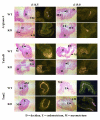Identification of 9 uterine genes that are regulated during mouse pregnancy and exhibit abnormal levels in the cyclooxygenase-1 knockout mouse
- PMID: 17617897
- PMCID: PMC1941732
- DOI: 10.1186/1477-7827-5-28
Identification of 9 uterine genes that are regulated during mouse pregnancy and exhibit abnormal levels in the cyclooxygenase-1 knockout mouse
Abstract
Background: Preterm birth is the leading cause of all infant mortality. In 2004, 12.5% of all births were preterm. In order to understand preterm labor, we must first understand normal labor. Since many of the myometrial changes that occur during pregnancy are similar in mice and humans and mouse gestation is short, we have studied the uterine genes that change in the mouse during pregnancy. Here, we used microarray analysis to identify uterine genes in the gravid mouse that are differentially regulated in the cyclooxygenase-1 knockout mouse model of delayed parturition.
Methods: Gestational d18.0 uteri (n = 4) were collected from pregnant wild-type and cyclooxygenase-1 knockout mice. Part of the uterus was used for frozen sections and RNA was isolated from the remainder. Microarray analysis was performed at the Indiana University School of Medicine Genomic Core and analyzed using the Microarray Data Portal. Northern analysis was performed to confirm microarray data and the genes localized in the gravid uterus by in situ hybridization.
Results: We identified 277 genes that are abnormally expressed in the gravid d18.0 cyclooxygenase-1 knockout mouse. Nine of these genes are also regulated in the normal murine uterus during the last half of gestation. Many of these genes are involved in the immune response, consistent with an important role of the immune system in parturition. Expression of 4 of these genes; arginase I, IgJ, Tnfrsf9 and troponin; was confirmed by Northern analysis to be mis-regulated during pregnancy in the knockout mouse. In situ hybridization of these genes demonstrated a similar location in the gravid wild-type and Cox-1 knockout mouse uteri.
Conclusion: To our knowledge, this is the first work to demonstrate the uterine location of these 4 genes in the mouse during late pregnancy. There are several putative transcription factor binding sites that are shared by many of the 9 genes identified here including; estrogen and progesterone response elements and Ets binding sites. In summary, this work identifies 9 uterine murine genes that may play a role in parturition. The function of these genes is consistent with an important role of the immune system in parturition.
Figures





Similar articles
-
Uterine expression of prostaglandin H2 synthase in late pregnancy and during parturition in prostaglandin F receptor-deficient mice.Endocrinology. 2000 Jan;141(1):315-24. doi: 10.1210/endo.141.1.7236. Endocrinology. 2000. PMID: 10614653
-
Angiogenesis gene expression in mouse uterus during the common pathway of parturition.Am J Obstet Gynecol. 2008 May;198(5):539.e1-8. doi: 10.1016/j.ajog.2007.11.021. Am J Obstet Gynecol. 2008. PMID: 18455529
-
Human myometrial gene expression before and during parturition.Biol Reprod. 2005 Mar;72(3):707-19. doi: 10.1095/biolreprod.104.032979. Epub 2004 Oct 27. Biol Reprod. 2005. PMID: 15509731 Clinical Trial.
-
Genetic analysis of fetal development and parturition control in the mouse.Pediatr Res. 2000 Apr;47(4 Pt 1):437-43. doi: 10.1203/00006450-200004000-00005. Pediatr Res. 2000. PMID: 10759148 Review.
-
Genomics of preterm birth.Cold Spring Harb Perspect Med. 2015 Feb 2;5(2):a023127. doi: 10.1101/cshperspect.a023127. Cold Spring Harb Perspect Med. 2015. PMID: 25646385 Free PMC article. Review.
Cited by
-
Striking differences between knockout and wild-type mice in global gene expression variability.PLoS One. 2014 May 15;9(5):e97734. doi: 10.1371/journal.pone.0097734. eCollection 2014. PLoS One. 2014. PMID: 24830645 Free PMC article.
-
Changes in global gene expression in rat myometrium in transition from late pregnancy to parturition.Physiol Genomics. 2009 Jan 8;36(2):89-97. doi: 10.1152/physiolgenomics.00290.2007. Epub 2008 Nov 11. Physiol Genomics. 2009. PMID: 19001510 Free PMC article.
-
Analyses of porcine public SNPs in coding-gene regions by re-sequencing and phenotypic association studies.Mol Biol Rep. 2011 Aug;38(6):3805-20. doi: 10.1007/s11033-010-0496-1. Epub 2010 Nov 24. Mol Biol Rep. 2011. PMID: 21107721
-
Tumor necrosis factor receptor subfamily 9 (Tnfrsf9) gene is expressed in distinct cell populations in mouse uterus and conceptus during implantation period of pregnancy.Cell Tissue Res. 2011 Jun;344(3):567-76. doi: 10.1007/s00441-011-1171-0. Epub 2011 May 12. Cell Tissue Res. 2011. PMID: 21560035 Free PMC article.
-
Maternal age effects on myometrial expression of contractile proteins, uterine gene expression, and contractile activity during labor in the rat.Physiol Rep. 2015 Apr;3(4):e12305. doi: 10.14814/phy2.12305. Physiol Rep. 2015. PMID: 25876907 Free PMC article.
References
-
- Martin JA, Hamilton BE, Sutton PD, Ventura SJ, Menacker F, Kirmeyer S. Births: Final Data for 2004. Natl Vital Stat Rep. 2006;55:1–101. - PubMed
-
- NIH Consensus Development Panel on the Effect of Corticosteroids forFetal Maturation on Perinatal Outcomes Effect of corticosteroids for fetal maturation on perinatal outcomes. NIH Consensus Development Panel on the Effect of Corticosteroids for Fetal Maturation on Perinatal Outcomes. JAMA. 1995;273:413–418. doi: 10.1001/jama.273.5.413. - DOI - PubMed
Publication types
MeSH terms
Substances
Grants and funding
LinkOut - more resources
Full Text Sources
Molecular Biology Databases
Research Materials

